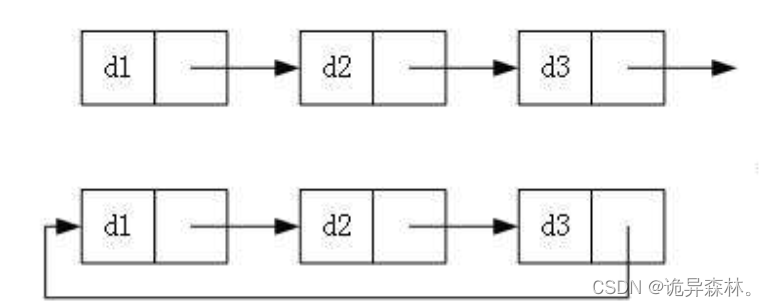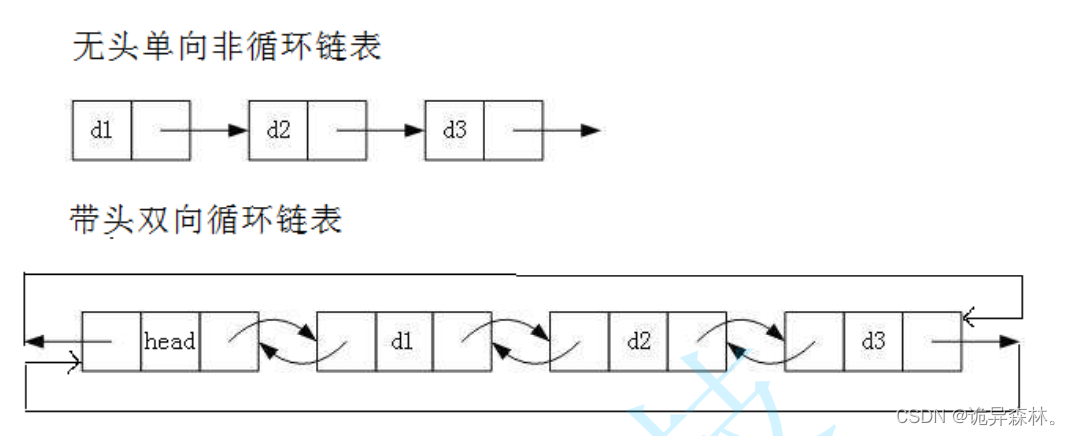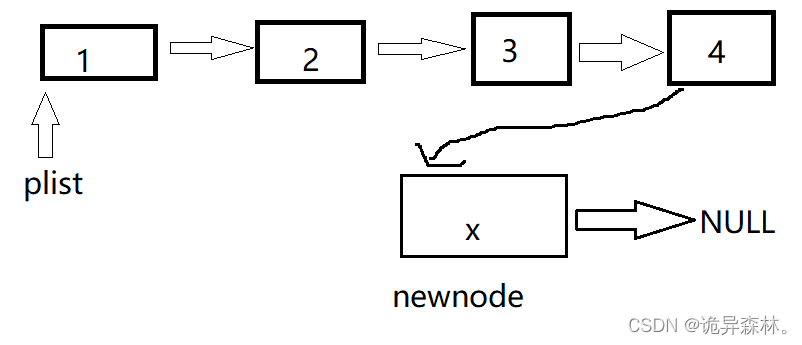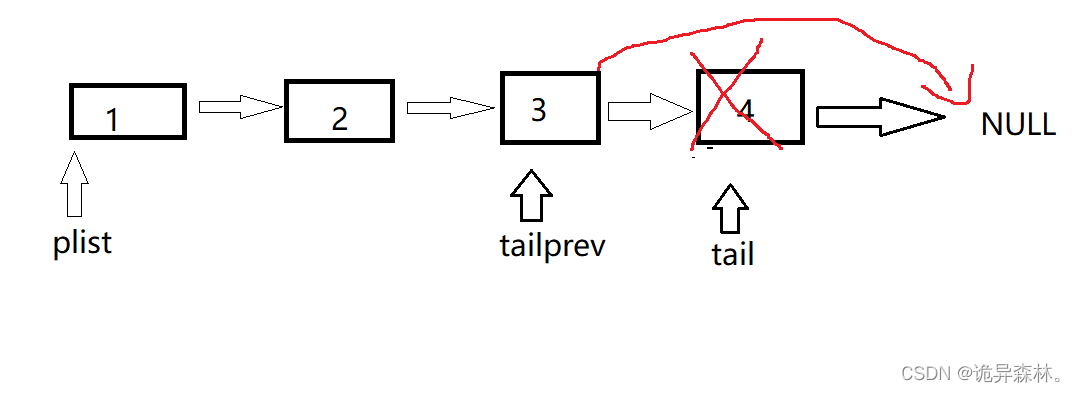前言
上一章,我们讲了数据结构--动态顺序表,我们会发现有以下问题:
1.当我们要头部或者插入或删除时,都需要进行位置挪动,腾出某一个位置,时间复杂度为0(N);
2.增容需要申请新空间,拷贝数据,释放旧空间。会有不小的消耗。
3.增容会有一定的浪费空间;例如当前容量为100,满了以后增容到200,我们再继续插入了5个数据,后面没有数据插入了,那么就浪费了95个数据空间。
下面我们来看看单链表这种线性结构;
链表
概念与结构
链表是一种常见的数据结构,用于存储和组织数据。它由一系列节点组成,每个节点包含两部分:数据和指向下一个节点的指针。
链表中的节点在内存中可以分布在任意位置,不像数组那样需要连续的存储空间。每个节点都包含了存储的数据以及指向下一个节点的指针。通过这种方式,链表可以灵活地分配和管理内存空间。就像一节节连动的火车车厢;

在数据结构中,呈现:
 逻辑图中,呈现:
逻辑图中,呈现:

在逻辑图中,链式结构是连续性的,但实际上不一样连续;从数据结构中看出,链表是通过地址来联系在一起的,不需要地址的连续性;在我们要解决链表相关问题时,只需要画出逻辑图即可;
注意:
结点的空间在堆区中开辟;堆区中申请出的空间,会按照一定的策略进行分配,两次申请的空间可能连续,可能不连续;
链表的分类
实际中链表的结构非常多样,以下情况组合起来就有8种链表结构:
1. 单向或者双向
2. 带头或者不带头

3. 循环或者非循环

可以通过一定的组合达成不同种类的链表;
这里我们比较常用的是有两种结构:

在这里,我们将先实现无头单向非循环链表,这是链表中结构最为简单的;简称单链表。
单链表的接口实现
先写一下它的结构:
#include<stdio.h>
#include<assert.h>
#include<stdlib.h>typedef int SLTDataType;
typedef struct SLTNode
{SLTDataType data;struct SListNode* next;}SLTNode;结构体中放入一个数据存储类型和一个结构体指针;结构体指针存放下一个结点的地址;
单链表打印
void SLTrint(SLTNode* phead)
{SLTNode* cur = phead;while (cur){printf("%d->", cur->data);cur = cur->next;}printf("NULL\n");
}将链表从头到尾遍历一遍,用一个cur指针来进行移动,在while循环中不断遍历打印出结果;打印完就进入下一个结点;
增加链表结点
SLTNode* BuySListNode(SLTDataType x)
{SLTNode* newnode = (SLTNode*)malloc(sizeof(SLTNode));if (newnode == NULL){perror("mallco fail");exit(-1);}newnode->data = x;newnode->next = NULL;return newnode;
}用动态内存分配进行扩容,同时对data和next进行初始化;最后返回结点;
尾插
void SLPushBack(SLTNode** pphead, SLTDataType x)
{assert(pphead);SLTNode* newnode = BuySListNode(x);if (* pphead == NULL){* pphead = newnode;}else{SLTNode* tail = * pphead;while (tail->next != NULL){tail = tail->next;}tail->next = newnode;}}这里要注意,我们的形参用到了二级指针,因为当结构体指针为空时,我们就需要对结构体指针进行改变,用二级指针接收结构体指针的地址,能够有效的访问,否则将会报错;当结构体指针不为空时,就利用结构体指针通过循环访问到尾结点,然后在尾结点进行连接;
验证:
void Test3()
{SLTNode* plist = NULL;SLPushBack(&plist, 1);SLPushBack(&plist, 2);SLPushBack(&plist, 3);SLPushBack(&plist, 4);SLTrint(plist);}
int main()
{Test3();return 0;
}
尾删
void SLPopBack(SLTNode** pphead)
{assert(pphead);//判空assert(*pphead);//一个节点if ((*pphead)->next == NULL){free(*pphead);*pphead = NULL;}//其他else{SLTNode* tailPrev = NULL;SLTNode* tail = *pphead;while (tail->next){tailPrev = tail;tail = tail->next;}free(tail);tailPrev->next = NULL;}
}当删除的是第一个结点,将会改变结构体指针的地址,所以形参要引用二级指针;其他情况就先找到尾结点,然后进行删除;
验证:
void Test3()
{SLTNode* plist = NULL;SLPushBack(&plist, 1);SLPushBack(&plist, 2);SLPushBack(&plist, 3);SLPushBack(&plist, 4);SLTrint(plist);SLPopBack(&plist);SLTrint(plist);}
int main()
{Test3();return 0;
}
头插头删
void SLPushFront(SLTNode** pphead, SLTDataType x)
{assert(pphead);SLTNode* newnode = BuySListNode(x);newnode->next = *pphead;*pphead = newnode;}void SLPopFront(SLTNode** pphead)
{ assert(pphead);//判空assert(*pphead);//其他SLTNode* newhead = (*pphead)->next;free(*pphead);*pphead = newhead;
}头插相对尾插来说比较容易,因为有头指针,所以不用遍历循环来找到尾结点;并且无论头节点是否为空,操作程序都保持一致;
头删只要找到头结点的下一个结点,那么就可以删除了;
验证:
void Test2()
{SLTNode* plist = NULL;SLPushBack(&plist, 1);SLPushBack(&plist, 2);SLPushBack(&plist, 3);SLPushBack(&plist, 4);SLPushBack(&plist, 5);SLTrint(plist);SLPushFront(&plist, 6);SLPushFront(&plist, 7);SLPushFront(&plist, 8);SLPushFront(&plist, 9);SLTrint(plist);SLPopFront(&plist);SLTrint(plist);}int main()
{Test2();return 0;
}
查找与插入
SLTNode* SLFind(SLTNode* phead, SLTDataType x)
{//判空assert(phead);SLTNode* cur = phead;while (cur){if (cur->data == x){return cur;}cur = cur->next;}return NULL;
}void SLTInsertAfter(SLTNode* pos, SLTDataType x)
{assert(pos);SLTNode* newnode = BuySListNode(x);newnode->next = pos->next;pos->next = newnode;}查找:在循环里面通过结点的data与x进行匹配,找到就返回该结点,找不到返回空;如果有多个结点的data与x一致,返回链表最接近头指针的;
插入:是在pos后面进行插入,这样插入比较方便,不用考虑头指针是否为空的问题;
验证:
void Test3()
{SLTNode* plist = NULL;SLPushBack(&plist, 1);SLPushBack(&plist, 2);SLPushBack(&plist, 3);SLPushBack(&plist, 4);SLTrint(plist);SLTNode* pos = SLFind(plist, 3);SLTInsertAfter(pos, 88);SLTrint(plist);}
int main()
{Test3();return 0;
}
删除pos结点
void SLTErase(SLTNode** pphead, SLTNode* pos)
{assert(pos);if (pos == *pphead){SLPopFront(pphead);}else{SLTNode* perv = *pphead;while (perv->next != pos){perv = perv->next;}perv->next = pos->next;free(pos);}
}void SLTEraseAfter(SLTNode* pos)
{assert(pos);//检查尾节点assert(pos->next);SLTNode* posNext = pos->next;pos->next = posNext->next;free(posNext);}第一种删除是删除pos结点,但需要判断该结点是否为首结点;而且需要遍历找到pos结点的前一个结点;比较麻烦;
第二种删除是删除pos结点后一个结点,只需要通过pos结点连接到下下一个结点即可,最后free掉pos的下一个结点;
验证:
void Test3()
{SLTNode* plist = NULL;SLPushBack(&plist, 1);SLPushBack(&plist, 2);SLPushBack(&plist, 3);SLPushBack(&plist, 4);SLTrint(plist);SLTNode* pos = SLFind(plist, 3);SLTInsertAfter(pos, 88);SLTrint(plist);SLTErase(&plist, pos);SLTrint(plist);}
int main()
{Test3();return 0;
}
void Test3()
{SLTNode* plist = NULL;SLPushBack(&plist, 1);SLPushBack(&plist, 2);SLPushBack(&plist, 3);SLPushBack(&plist, 4);SLTrint(plist);SLTNode* pos = SLFind(plist, 3);SLTInsertAfter(pos, 88);SLTrint(plist);SLTEraseAfter(pos);SLTrint(plist);}
int main()
{Test3();return 0;
}
摧毁
void SLTDestroy(SLTNode** pphead)
{assert(pphead);SLTNode* cur = *pphead;while (cur){SLTNode* prev = cur;cur = cur->next;free(prev);}*pphead = NULL;
}通过记住头结点的下一个结点,free掉头节点,然后头节点的下一个结点成为新的头节点;
验证:
void Test3()
{SLTNode* plist = NULL;SLPushBack(&plist, 1);SLPushBack(&plist, 2);SLPushBack(&plist, 3);SLPushBack(&plist, 4);SLTrint(plist);SLTNode* pos = SLFind(plist, 3);SLTInsertAfter(pos, 88);SLTrint(plist);SLTDestroy(&plist);SLTrint(plist);
}
int main()
{Test3();return 0;
}
完整代码
slist.h
#pragma once
#include<stdio.h>
#include<assert.h>
#include<stdlib.h>typedef int SLTDataType;
typedef struct SLTNode
{SLTDataType data;struct SListNode* next;}SLTNode;void SLTrint(SLTNode* phead);
SLTNode* BuySListNode(SLTDataType x);
void SLPushBack(SLTNode** pphead, SLTDataType x);
void SLPushFront(SLTNode** pphead, SLTDataType x);
void SLPopBack(SLTNode** pphead);
void SLPopFront(SLTNode** pphead);
SLTNode* SLFind(SLTNode* phead, SLTDataType x);
void SLTInsertAfter(SLTNode* pos, SLTDataType x);
void SLTErase(SLTNode** pphead, SLTNode* pos);
void SLTEraseAfter(SLTNode* pos);
void SLTDestroy(SLTNode** phead);slist.c
#define _CRT_SECURE_NO_WARNINGS 1
#include"Slist.h"void SLTrint(SLTNode* phead)
{SLTNode* cur = phead;while (cur){printf("%d->", cur->data);cur = cur->next;}printf("NULL\n");
}SLTNode* BuySListNode(SLTDataType x)
{SLTNode* newnode = (SLTNode*)malloc(sizeof(SLTNode));if (newnode == NULL){perror("mallco fail");exit(-1);}newnode->data = x;newnode->next = NULL;return newnode;
}void SLPushBack(SLTNode** pphead, SLTDataType x)
{assert(pphead);SLTNode* newnode = BuySListNode(x);if (* pphead == NULL){* pphead = newnode;}else{SLTNode* tail = * pphead;while (tail->next != NULL){tail = tail->next;}tail->next = newnode;}}void SLPushFront(SLTNode** pphead, SLTDataType x)
{assert(pphead);SLTNode* newnode = BuySListNode(x);newnode->next = *pphead;*pphead = newnode;}void SLPopBack(SLTNode** pphead)
{assert(pphead);//判空assert(*pphead);//一个节点if ((*pphead)->next == NULL){free(*pphead);*pphead = NULL;}//其他else{SLTNode* tailPrev = NULL;SLTNode* tail = *pphead;while (tail->next){tailPrev = tail;tail = tail->next;}free(tail);tailPrev->next = NULL;}
}
void SLPopFront(SLTNode** pphead)
{ assert(pphead);//判空assert(*pphead);//其他SLTNode* newhead = (*pphead)->next;free(*pphead);*pphead = newhead;
}SLTNode* SLFind(SLTNode* phead, SLTDataType x)
{//判空assert(phead);SLTNode* cur = phead;while (cur){if (cur->data == x){return cur;}cur = cur->next;}return NULL;
}void SLTInsertAfter(SLTNode* pos, SLTDataType x)
{assert(pos);SLTNode* newnode = BuySListNode(x);newnode->next = pos->next;pos->next = newnode;}void SLTErase(SLTNode** pphead, SLTNode* pos)
{assert(pos);if (pos == *pphead){SLPopFront(pphead);}else{SLTNode* perv = *pphead;while (perv->next != pos){perv = perv->next;}perv->next = pos->next;free(pos);}
}void SLTEraseAfter(SLTNode* pos)
{assert(pos);//检查尾节点assert(pos->next);SLTNode* posNext = pos->next;pos->next = posNext->next;free(posNext);}void SLTDestroy(SLTNode** pphead)
{assert(pphead);SLTNode* cur = *pphead;while (cur){SLTNode* prev = cur;cur = cur->next;free(prev);}*pphead = NULL;
}test.c
#define _CRT_SECURE_NO_WARNINGS 1
#include"Slist.h"void Test1()
{int n;SLTNode* plist = NULL;printf("请输入链表长度");scanf("%d", &n);printf("请输入值");for (int i = 0; i < n; i++){int val;scanf("%d", &val);SLTNode* newnode = BuySListNode(val);newnode->next = plist;plist = newnode;}SLTrint(plist);
}void Test2()
{SLTNode* plist = NULL;SLPushBack(&plist, 1);SLPushBack(&plist, 2);SLPushBack(&plist, 3);SLPushBack(&plist, 4);SLPushBack(&plist, 5);SLTrint(plist);SLPushFront(&plist, 6);SLPushFront(&plist, 7);SLPushFront(&plist, 8);SLPushFront(&plist, 9);SLTrint(plist);SLPopFront(&plist);SLTrint(plist);}void Test3()
{SLTNode* plist = NULL;SLPushBack(&plist, 1);SLPushBack(&plist, 2);SLPushBack(&plist, 3);SLPushBack(&plist, 4);SLTrint(plist);SLTNode* pos = SLFind(plist, 3);SLTInsertAfter(pos, 88);SLTrint(plist);SLTDestroy(&plist);SLTrint(plist);
}
int main()
{Test3();return 0;
}















)


)




 ,count(1)与count(*) 有何区别?)